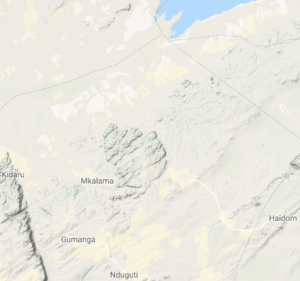Ihanzu (also known as Nyihansu or Isanzu) is a Bantu language spoken in the Tanzanian Rift Valley. I began studying Ihanzu in 2016. Below is a short introduction.
Isaac Isaac Shauri and Musa Gimbi flipping through photos of birds and describing them to each other. [Clip from: 20180704a (Harvey, forthcoming)]
The traditional homeland of the Ihanzu runs south from the Sibiti river for about forty kilometres, blending gradually into that of the Nyilamba people. Ihanzu-speaking communities can be found as far west as the Duromo river (running almost parallel to a sheer rift valley wall), and probably as far east as Haydom, where communities are mixed with Ihanzu, Iraqw, and Datooga-speakers. The north-flowing Sibiti empties into Lake Eyasi, where Ihanzu speakers and Hadza speakers are in regular contact.

Approximately where Ihanzu is traditionally spoken, with Lake Eyasi to the north, and the Sibiti river following roughly the same path as the leftmost dashed line. To the west, the Duromo river flows almost in parallel to the steep rift wall. Image c/o Google Maps
No dedicated language survey has been conducted to determine the number of Ihanzu speakers, but as part of its work on the Language Atlas of Tanzania, the Languages of Tanzania Project estimated that in 2009 there were 26,000 Ihanzu speakers in total.
How robustly Ihanzu is being passed to children is another question about which not much is known. An estimate of speaker figures in 1987 put the total number of Ihanzu speakers at 32,000, meaning the new figures represent a reduction in speaker numbers of 20% over 20 years. This is almost certainly too high of an obsolescence rate, as I have observed children in rural areas still continuing to learn and use the language.
With that said, finding speakers in the nearest large town, Singida, is quite difficult, and children of Ihanzu families in this urban environment were not observed to use Ihanzu in most daily interactions, even at home. Anecdotally, Ihanzu speakers commonly talk about their language being subsumed by Nyilamba a large language which exists side-by-side with Ihanzu in southern parts of the Ihanzu speaking area. This kind of hearsay lacks rigour, but has occurred consistently enough to assume that Isanzu is under considerable pressure from the neighbouring Nyilamba.
The Ihanzu have extensive oral accounts of a historical migration to their current homeland, and often recall moving south, often by or through Lake Victoria (Nyanza). The relationship with early European colonizers was often one of mutual distrust and hostility, with the Ihanzu taking active roles in regional resistance struggles.
The Ihanzu are notable in the Tanzanian Rift in that they are sedentary farmers, and see themselves unambiguously as such (as compared to other farming groups, who prefer to identify as pastoralists), with sorghum and (more recently) maize as important staple crops. Kinship is matrilineal and residence is (at least early in marriage) matrilocal. Culturally, the Ihanzu are renowned throughout the Rift Valley area for their rainmaking abilities, an institutionalized practice that continues to present day. Modern religions (forms of Christianity and Islam) have had less of an impact here than in other areas in the region, but communities of Christians and Muslims still exist, especially in towns and larger villages. These new faiths exist simultaneously with traditional faith.
Ihanzu is a Bantu language (like Zulu and Swahili). Because of a lack of empirical data, it has been impossible to further classify Ihanzu into a subgroup (e.g. whether it is related to “F-group” Nyilamba, or whether it is a member of an altogether older group of Bantu languages which were spoken here before F-group Bantu languages arrived). Phonetically, Ihanzu is notable in its lack of labiodental fricatives [f] and [v], as well as commonly reducing forms which, in nearby languages contain the sounds [s] or [ʃ] to [h] (compare mgosha ‘man’ in Nyilamba to mᵾgohá ‘man’ in Ihanzu). Morphologically, nouns feature an augment vowel which precedes the class prefix (this seems to function primarily to mark definiteness, but must be examined further in richer speech contexts). Diminutives are commonly formed by prefixing the form ngwa- (cf. ngwana ‘child’), thus: ngwanyumba ‘a small house’. Verbs form reciprocals with an object prefix -ki-, rather than a suffix -an-. Syntactically, relative clauses are formed with a prefix n-, rather than any sort of internal relative marker (e.g. inyonyi nikimba ‘the bird which is singing’). Further insights will come with more extensive analysis.
